How to fix internet access after updating Windows 11
Did you update Windows 11 and now can't access the internet? Here are the steps to fix this issue.
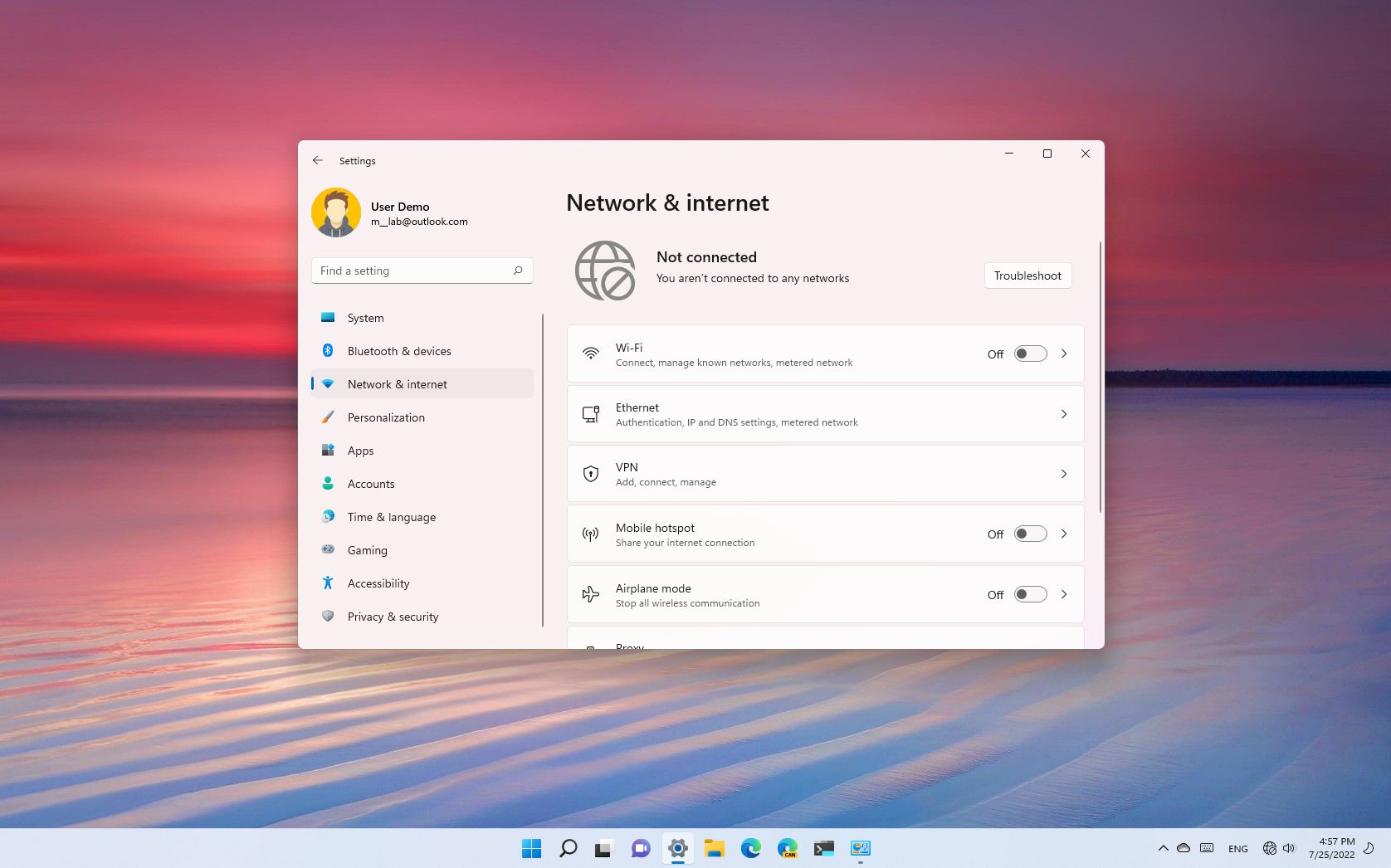
On Windows 11, Microsoft proactively releases updates to patch bugs, improve security and performance, and occasionally add new features. However, sometimes, system updates can also cause unwanted problems, and many times are connectivity issues.
For example, a lot of times, updates can make speeds and connections unreliable, especially with wireless adapters. Also, they can break connectivity entirely to the network and internet, cause network driver problems, and more.
If you cannot connect to the internet after installing a system update, Windows 11 offers several methods to resolve the issue and get back online quickly.
This guide will walk you through the steps to fix network issues after installing a Windows 11 update.
How to fix network problems after installing update
If the device was recently updated and the network connection breaks, you can try these basic troubleshooting steps to resolve the issue. If the problem persists, continue with the more advanced instructions outlined below.
Reboot device
Sometimes, you can fix most problems by restarting the computer since this process clears the data in memory and restarts all the applications and system services.
Get the Windows Central Newsletter
All the latest news, reviews, and guides for Windows and Xbox diehards.
To reboot a Windows 11 computer, use these steps:
- Open Start.
- Click the Power option.
- Select the Restart option.
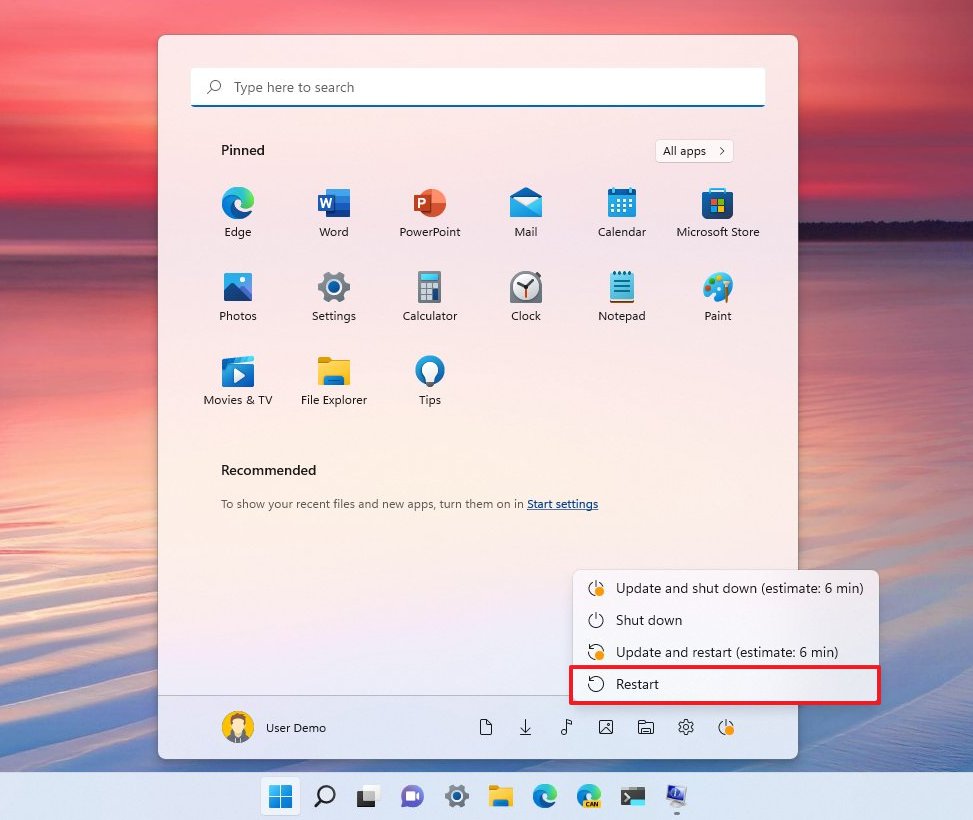
Once you complete the steps, open the web browser and load at least two or three websites to confirm the internet is working.
If only one of the sites isn't opening, it could be a problem with the website or the page and not the internet connection.
Network connection test
If the restart didn't solve the issue, you want to check whether the problem lies with the connection between the computer and the home router.
To check the network connectivity on Windows 11, use these steps:
- Open Start.
- Search for Command Prompt and click the top result to open the console.
- Type the following command to find out the IP address of the router and press Enter: ipconfig

- Confirm the "Default Gateway" address that should be the address of the local router.
- Quick tip: Usually, home routers use the 192.169.1.1 or 192.168.2.1 address.
- Type the following command to determine whether the router is reachable and press Enter: ping ROUTER-IP
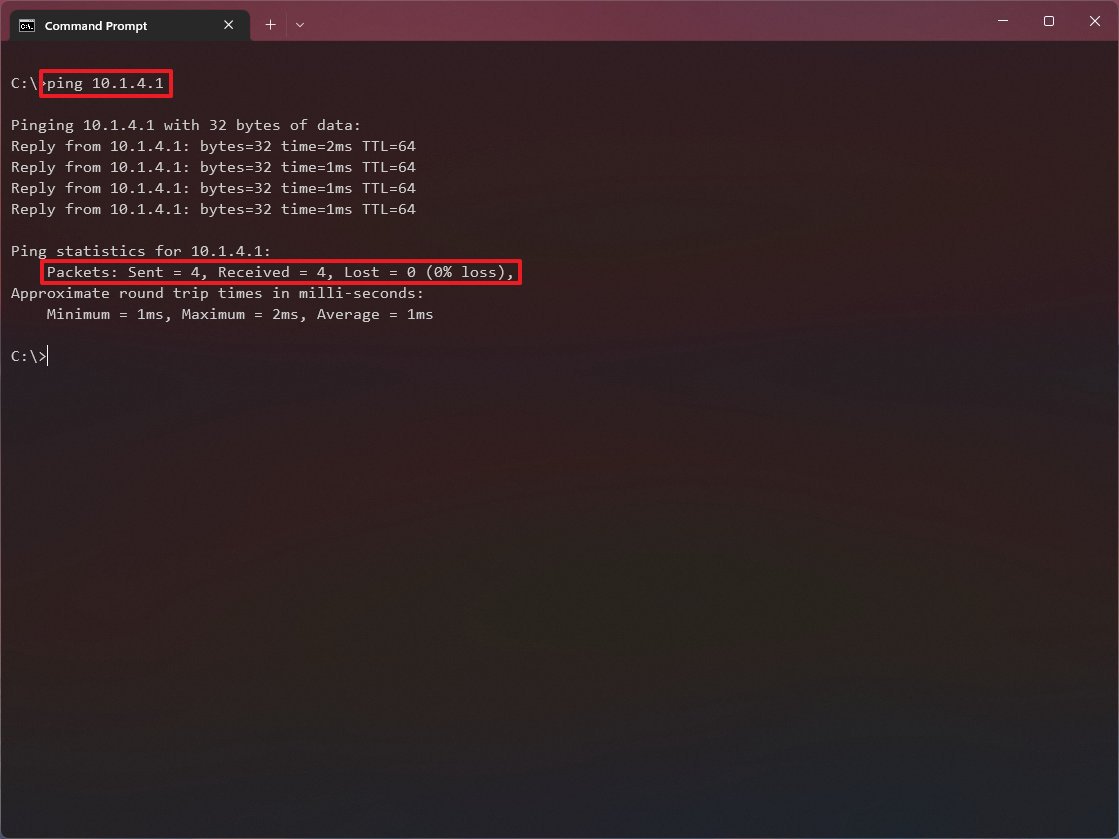
This example tests the connection between the computer to the router with the 192.168.1.1 address: ping 192.168.1.1 In the command, remember to change the 192.168.1.1 for the router's IP address.
- Quick tip: You can also use the ping 127.0.0.1 command to test whether the networking stack is installed correctly.
- Confirm successful replies without packet loss in the output.
After you complete the steps, if you see "4" successful replies in "Packets," the connection between the computer and router is working.
If this is the case, the problem could be something happening with your internet provider. However, if you can still access the internet from another device in the same network, it could be another problem with the computer.
Turn on wireless connection
If you have a laptop and there isn't a connection to the internet, the wireless adapter may be disabled.
To enable the Wi-Fi adapter on Windows 11, use these steps:
- Open Settings.
- Click on Network & internet.
- Turn on the Wi-Fi toggle switch.
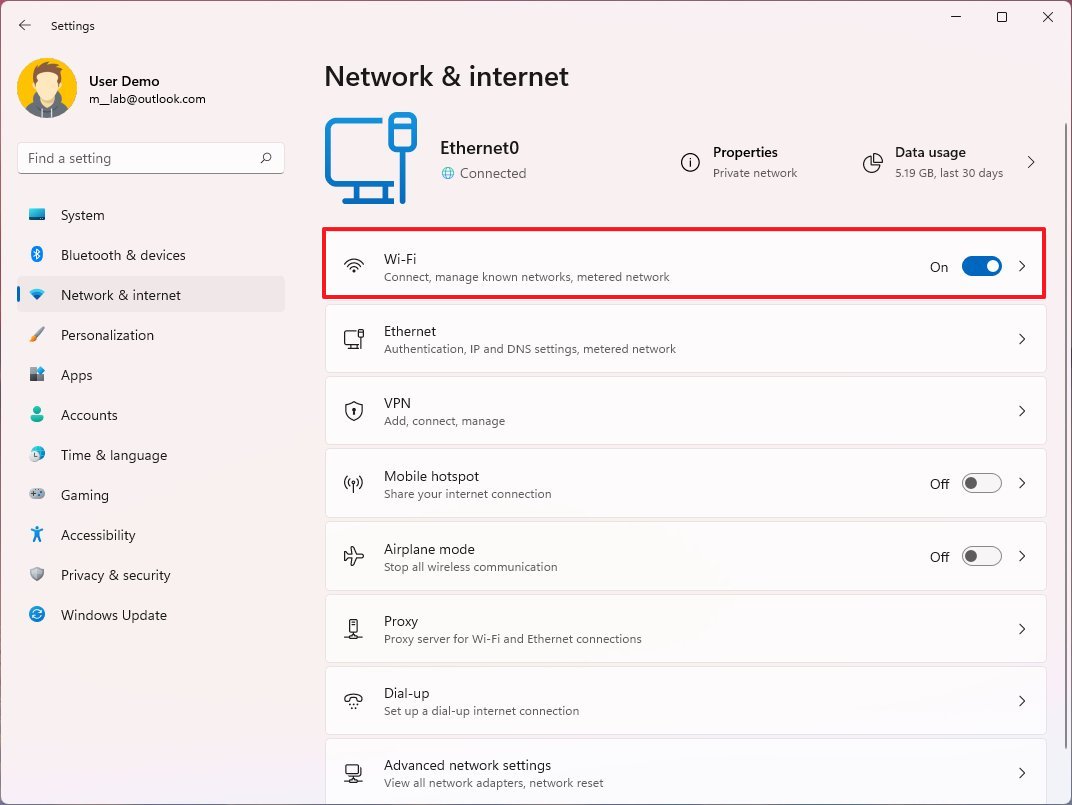
Alternatively, you can turn on the wireless adapter by opening the Quick Settings flyout (Windows key + A keyboard shortcut) and clicking the Wi-Fi button.
Also, ensure the physical wireless switch is turned on if you have a laptop. Otherwise, you won't be able to see or connect to any network.
Connect to wireless network
If there's a connection problem, you may be able to get around this problem by disconnecting and connecting the device to the access point.
To reconnect to the wireless network on Windows 11, use these steps:
- Open Settings.
- Click on Network & internet.
- Turn off the Wi-Fi toggle switch.
- Turn on the Wi-Fi toggle switch.

- (Optional) Click the Wi-Fi setting if the computer doesn't connect automatically.
- Select the wireless network under the "Show available networks" setting.
- Click the Connect button.
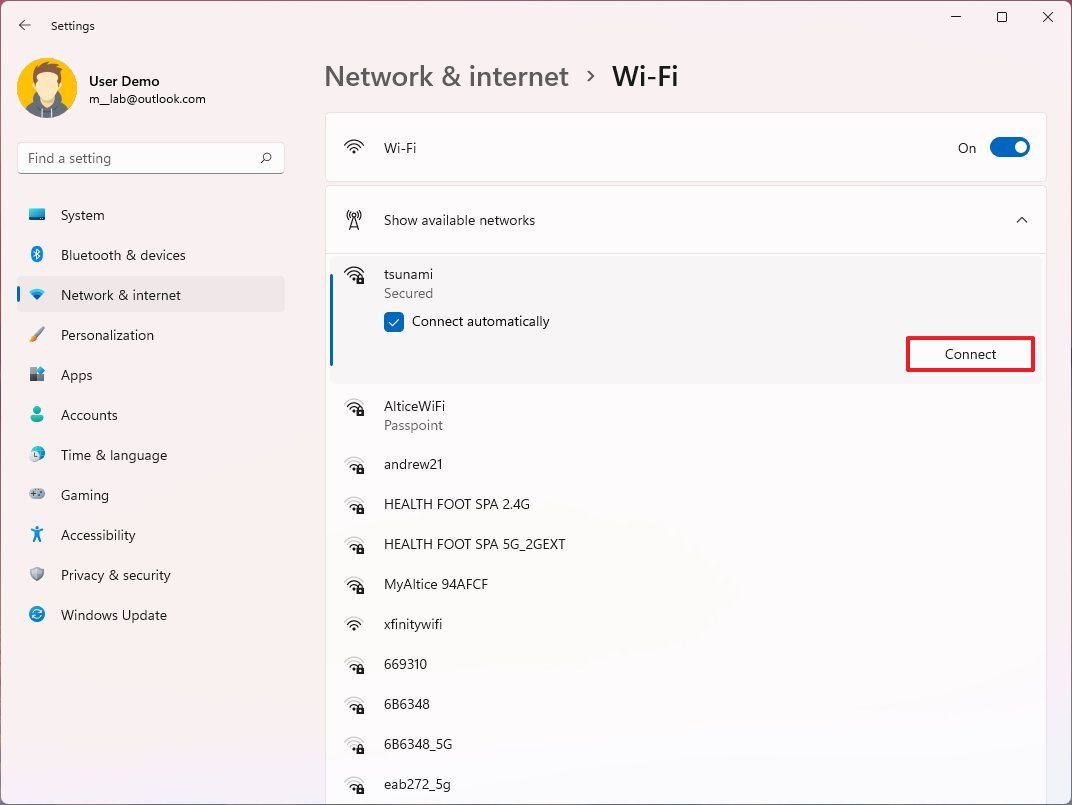
- Continue with the on-screen directions to connect.
Once you complete the steps, you should be able to connect to the internet.
If you're on a network with a router that offers different frequency bands (2.4GHz and 5GHz), you can try to switch bands to make a reliable connection.
Re-enable network adapter
On Windows 11, an update can inadvertently change settings without your consent, including disabling the network adapter or turning on Airplane mode.
If the network adapter is suddenly missing, it could be an issue with the drive, or the adapter might be disabled.
To enable a Wi-Fi or Ethernet adapter on Windows 11, use these steps:
- Open Settings.
- Click on Network & internet.
- Click the Advanced networks settings page on the right side.
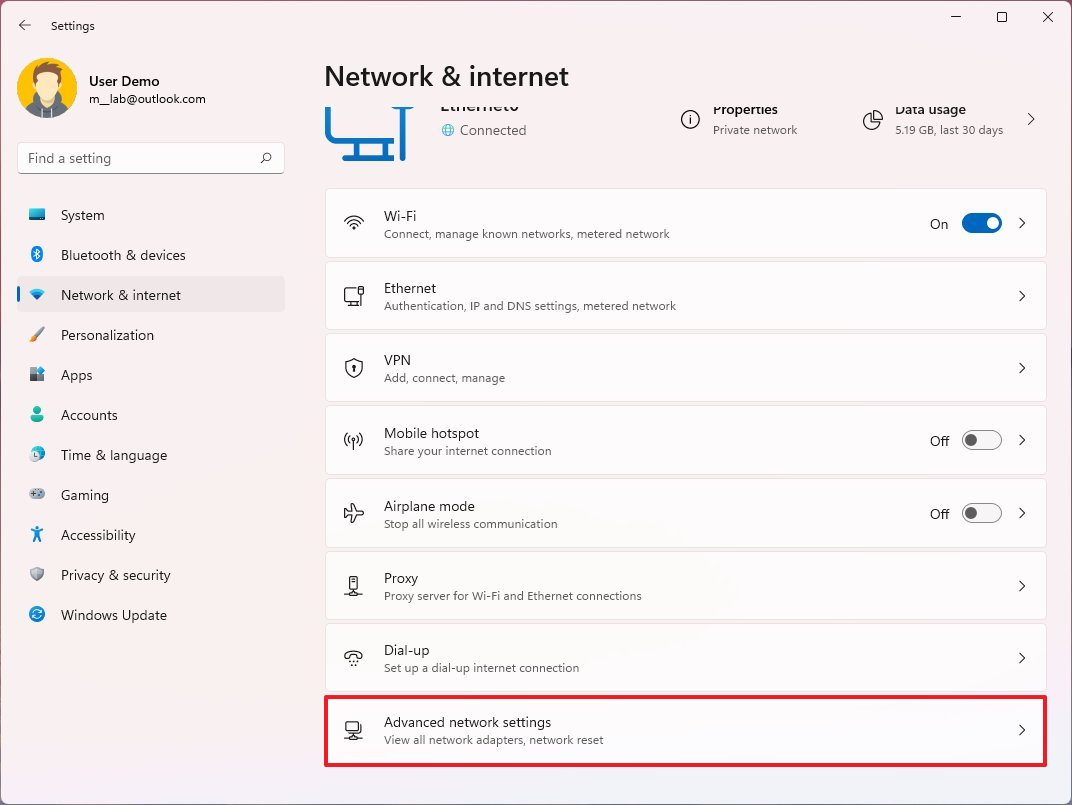
- Under the "Network adapters" section, click the Disable button for the adapter connected to the network.
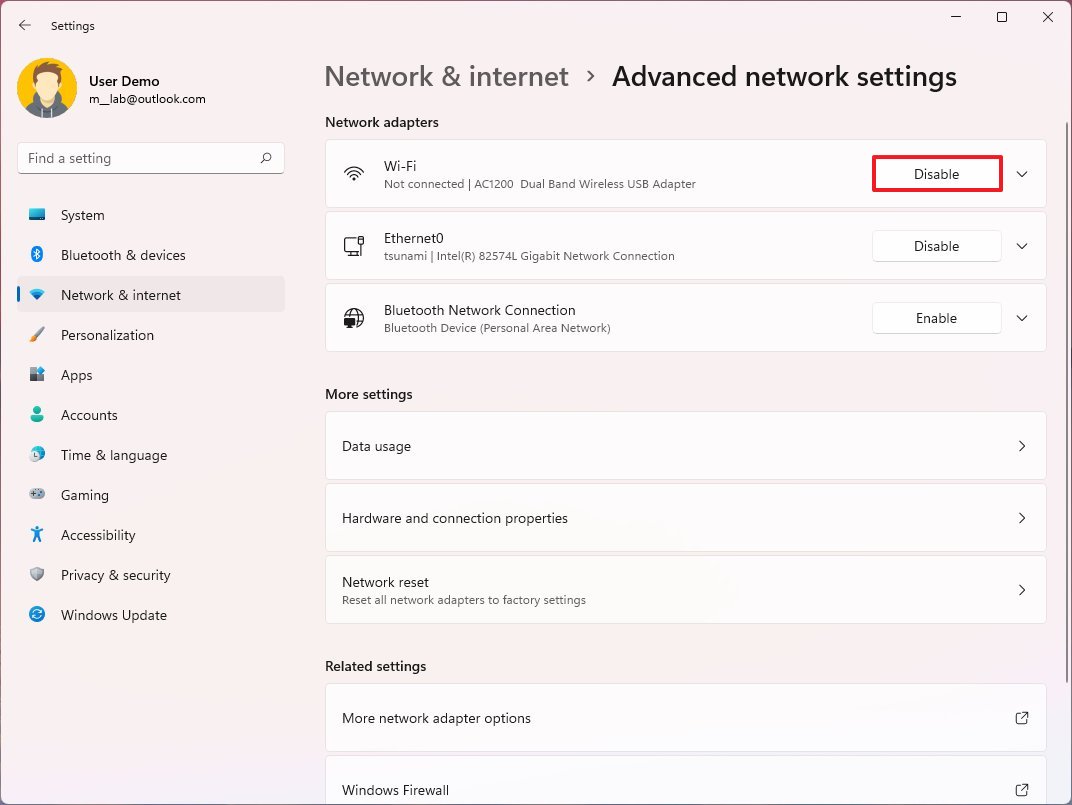
- Click the Enable button.
After you complete the steps, the network adapter will enable and reconfigure automatically to connect to the internet.
Disable Airplane mode
When Airplane mode is turned on, Windows 11 won't be able to connect to the internet. If this is the case, make sure to disable the feature.
To turn off Airplane mode on Windows 11, use these steps:
- Open Settings.
- Click on Network & internet.
- Turn off the Airplane mode toggle switch on the right side.
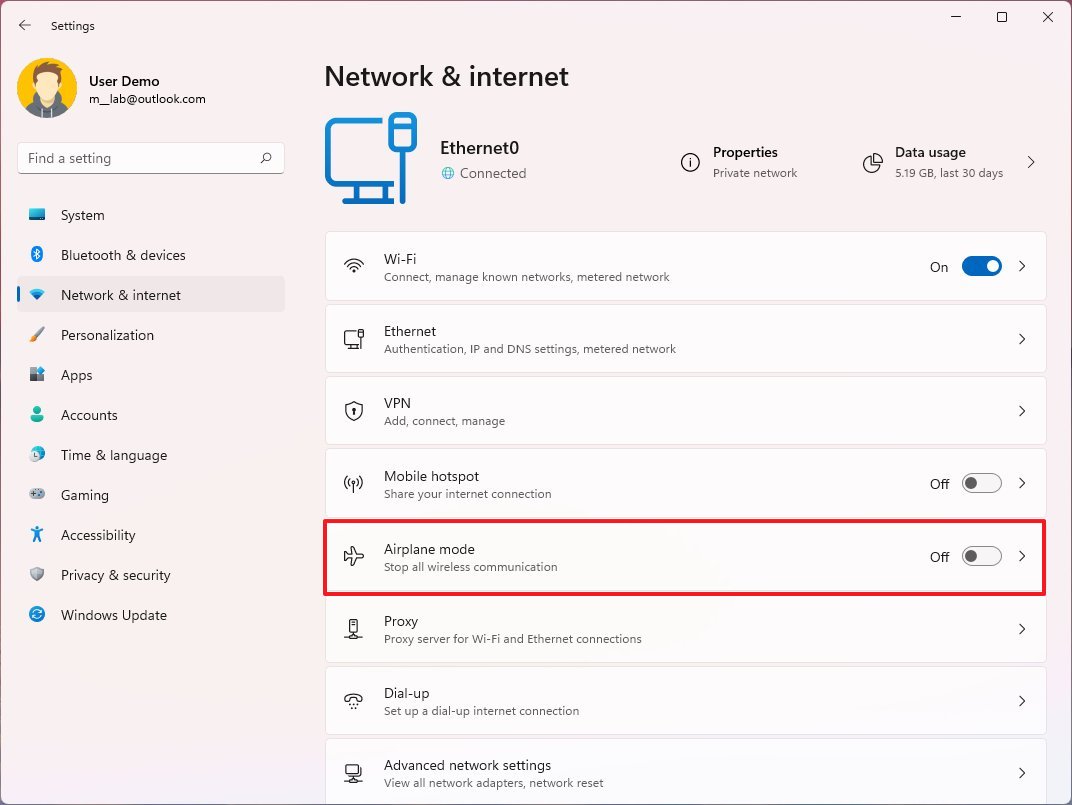
You can also turn off the feature from the Quick Settings flyout available through the Taskbar.
Reset wireless profile
The system creates a profile with connection details and credentials as you connect to a wireless network. If the profile gets corrupted during an update or due to another action, the computer won't connect to the network. In this case, you can delete and recreate the profile to fix the problem.
To recreate a wireless profile on Windows 11, use these steps:
- Open Settings.
- Click on Network & internet.
- Click the Wi-Fi page on the right side.

- Click the "Manage known networks" setting.
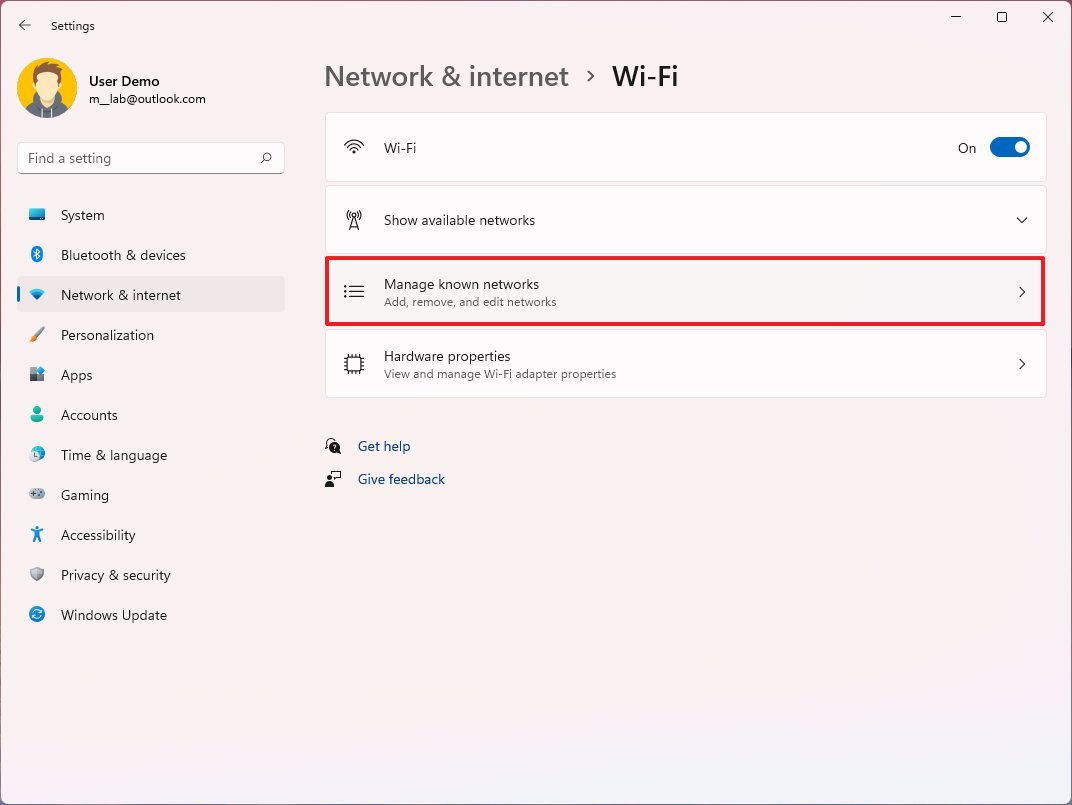
- Click the Forget button for the profile that isn't working.
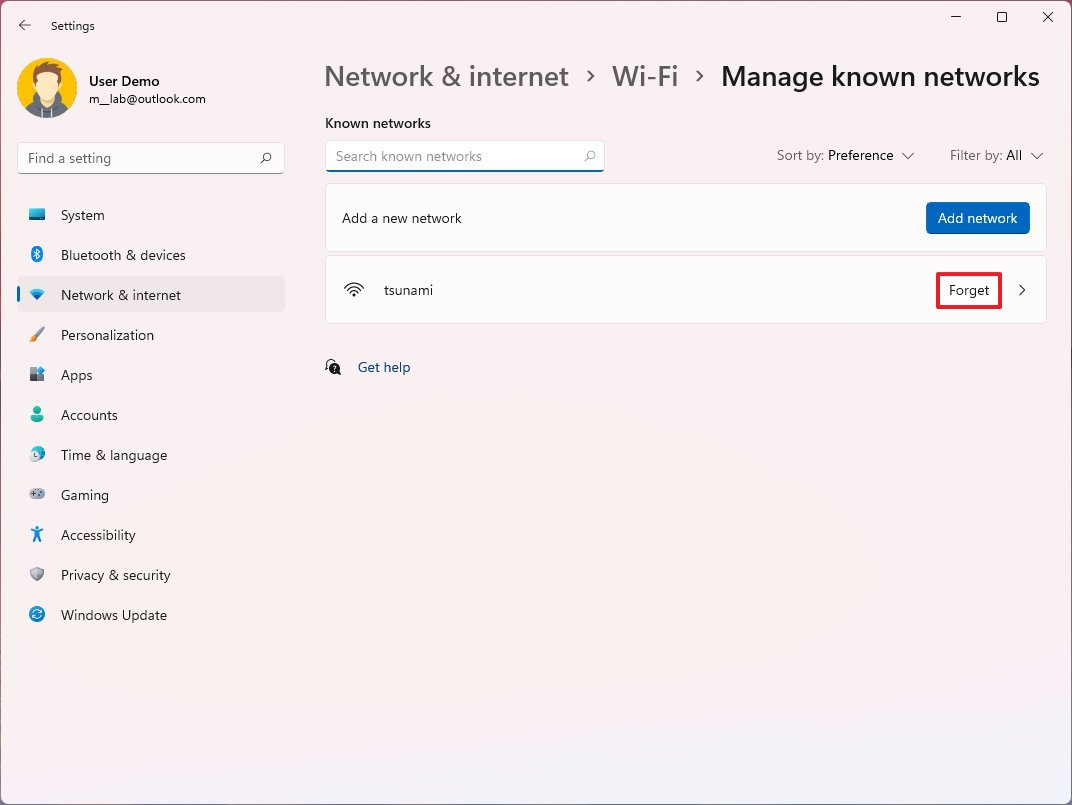
- Click the Back button to return to the Wi-Fi page.
- Select the wireless network under the "Show available networks" setting.
- Click the Connect button.

- Continue with the on-screen directions to connect.
Once you complete the steps, the computer should once again connect to the network and the internet.
You can refer to this guide for more details on how to manage wireless settings on Windows 11.
Restart home router
It can also be a coincidence that your home router stops working soon after updating to the most recent maintenance patch of Windows 11. If this is the case, restarting the network device may fix the connection and other networking issues.
To reboot the router (also referred to as modern or firewall), use these general steps:
- Locate the router.
- Unplug the power cord.
- Wait at least 60 seconds.
- Reconnect the power cord.
After you complete the steps, allow three to five minutes for the device to boot and check the connection.
How to fix internet access with Troubleshooter
On Windows 11, you can also use a specific troubleshooter to resolve networking issues on your computer.
To fix an internet connection with the network troubleshooter on Windows 11, use these steps:
- Open Settings.
- Click on System.
- Click the Troubleshoot page on the right side.
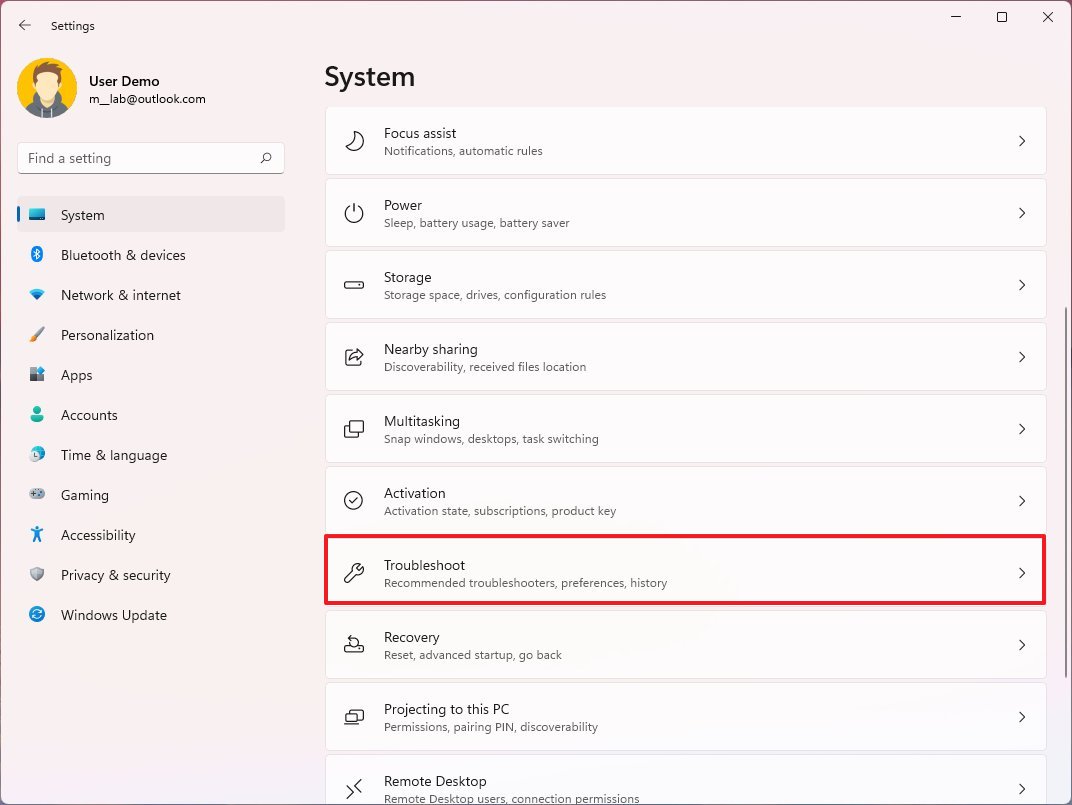
- Click the Other troubleshooters setting.
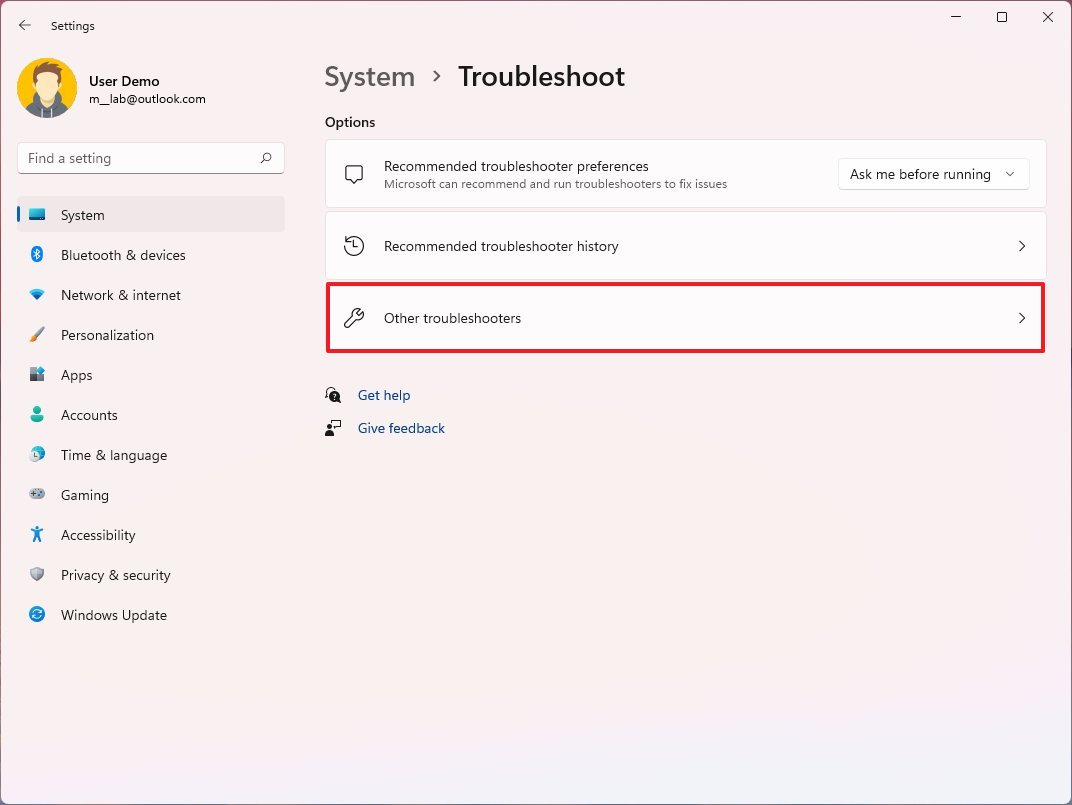
- Under the "Most frequent" section, click the Run button for the "Internet Connections" troubleshooter.

- Select the "Troubleshoot my connection to the internet" option.
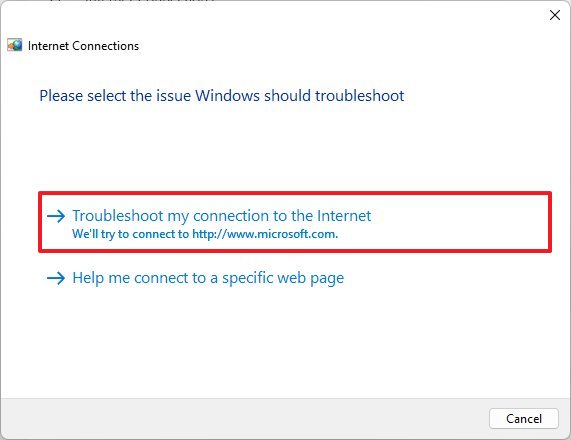
- Select the "Try these repairs as an administrator" option (if applicable).
- Continue with the on-screen directions (if applicable).
Once you complete the steps, the troubleshooter will scan and resolve any connectivity problem.
How to reset networking stack with Command Prompt
If the recently installed update messed up the Windows 11 networking stack, you can reset it to fix the problem on your laptop or desktop computer.
To reset the TCP/IP networking stack on Windows 11, use these steps:
- Open Start.
- Search for Command Prompt, right-click the top result, and select the Run as administrator option.
- Type the following command to reset the components that handle network requests and press Enter: netsh winsock reset
- Type the following command to reset the internet protocol (IP) stack and press Enter: netsh int ip reset
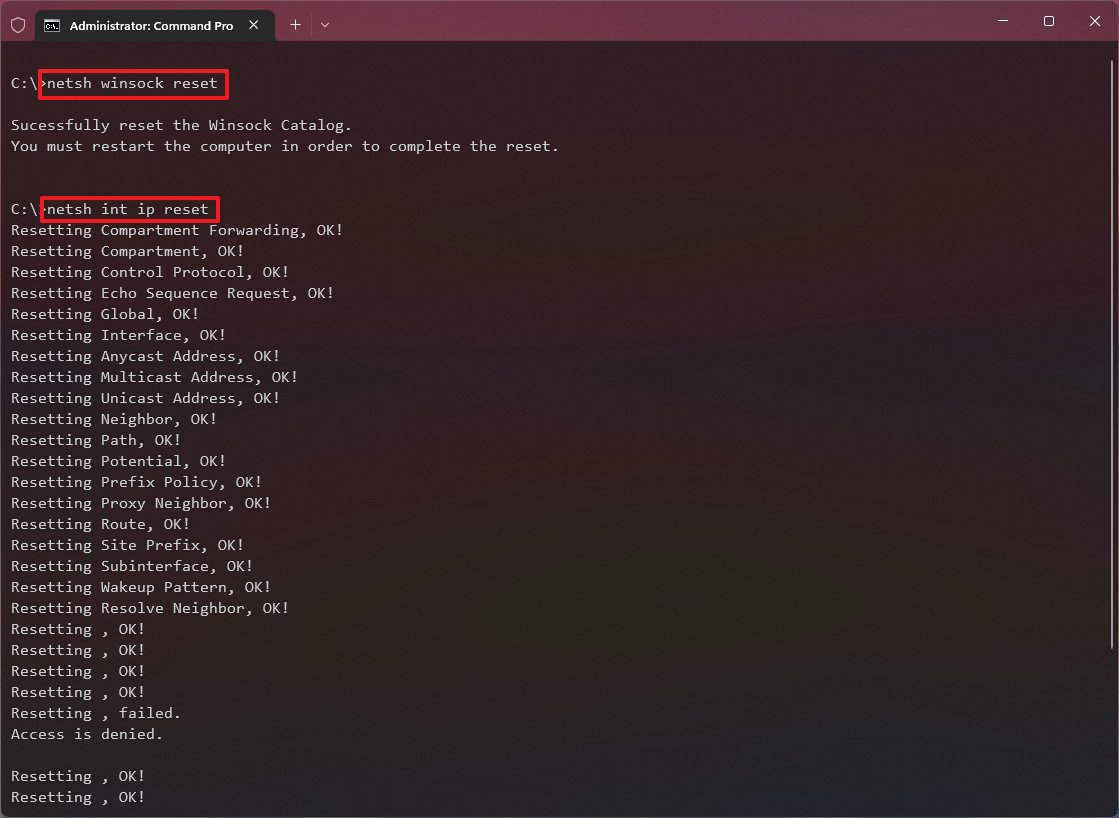
- Type the following command to clear the current networking configuration and press Enter: ipconfig /release
- Type the following command to reconfigure the network settings automatically and press Enter: ipconfig /renew
- Type the following command to clear the Domain Name System (DNS) information cached and press Enter: ipconfig /flushdns
- Restart your computer.
Once you complete the steps, open multiple websites with your preferred web browser to confirm whether the internet connection is working.
How to reset network adapters with Settings
At this point, if nothing seems to resolve the issue, you can reset all the network adapters' drivers and settings to the factory defaults to fix the connection problem.
To reset the Wi-Fi and Ethernet network adapters on Windows 11, use these steps:
- Open Settings.
- Click on Network & internet.
- Click the Advanced network settings page on the right side.

- Under the "More settings" section, click the Network reset setting.
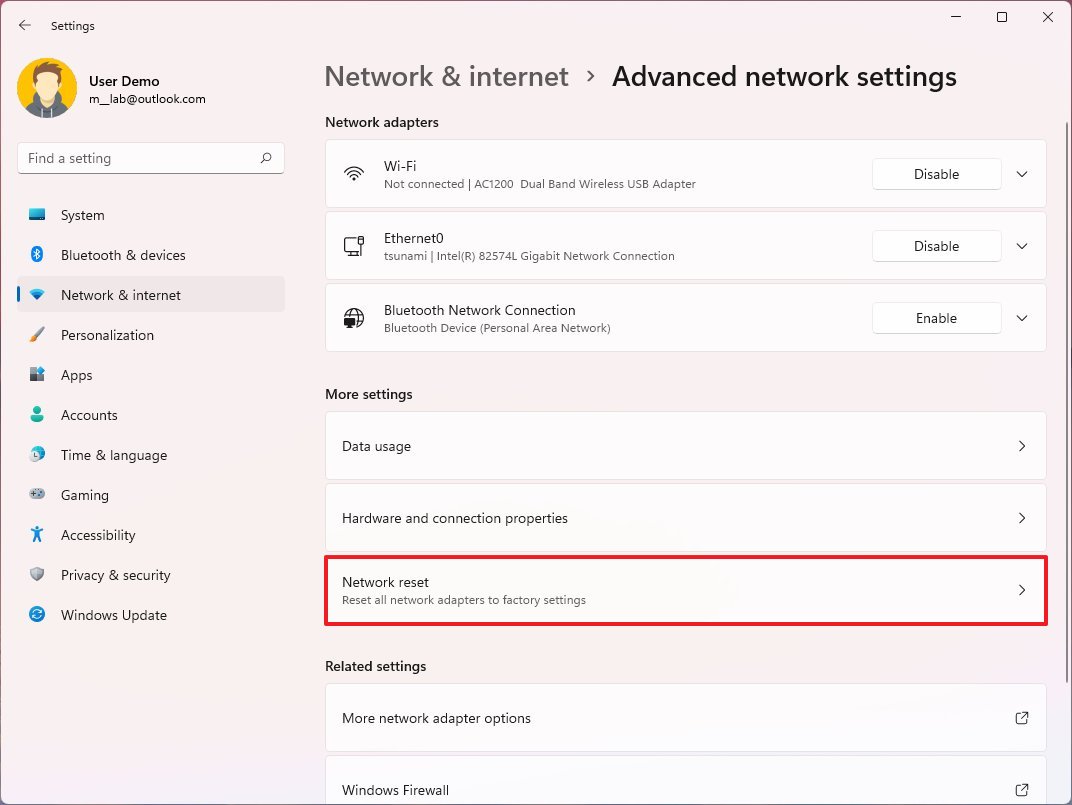
- Click the Reset now button.
- Click the Reset now button again.
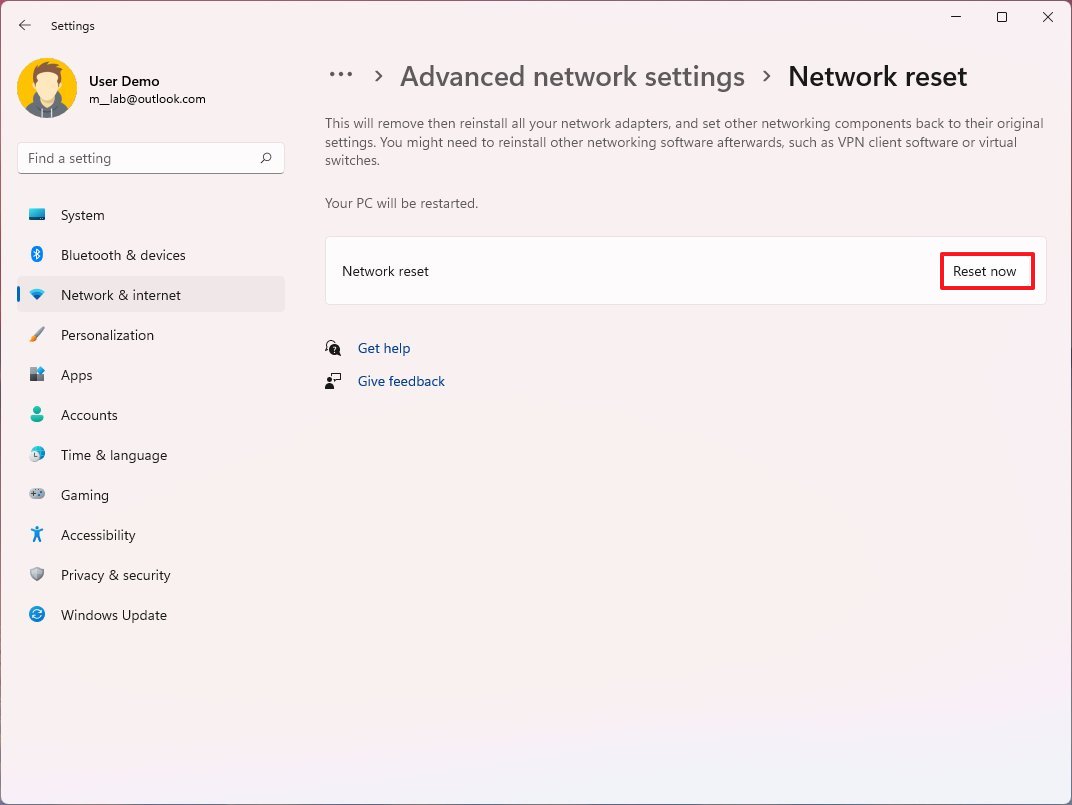
After you complete the steps, you should be able to connect to the network and the internet.
Resetting the networking adapters means you must re-enter the security key when connecting to the wireless network. Also, you will have to reconfigure other networking software, such as VPN clients (if applicable).
How to fix network driver problems on Windows 11
On Windows 11, it's common that a network adapter driver may cause compatibility problems after installing a feature or quality update. If this is the case, you have three options. You can update the network adapter driver, if applicable. You could uninstall the drive if a recent update damaged it. And you can try rolling back to a previous version of the driver since the device may still work with an older driver.
Update adapter driver online
If the computer doesn't have a reliable connection, but it's still possible to connect it to the internet, you can use Windows Update to check for driver updates.
To update the network driver on Windows 11, use these steps:
- Open Settings.
- Click on Windows Update.
- Click the Advanced options page on the right side.
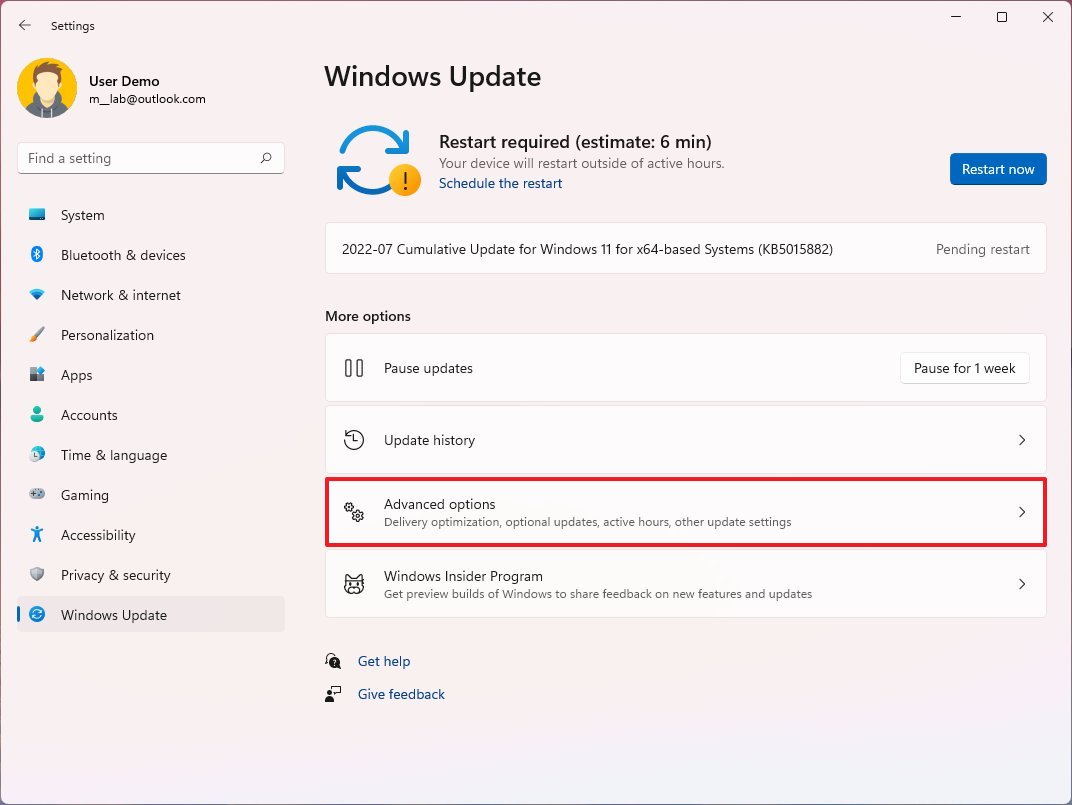
- Under the "Advanced options" section, click the Optional updates setting.
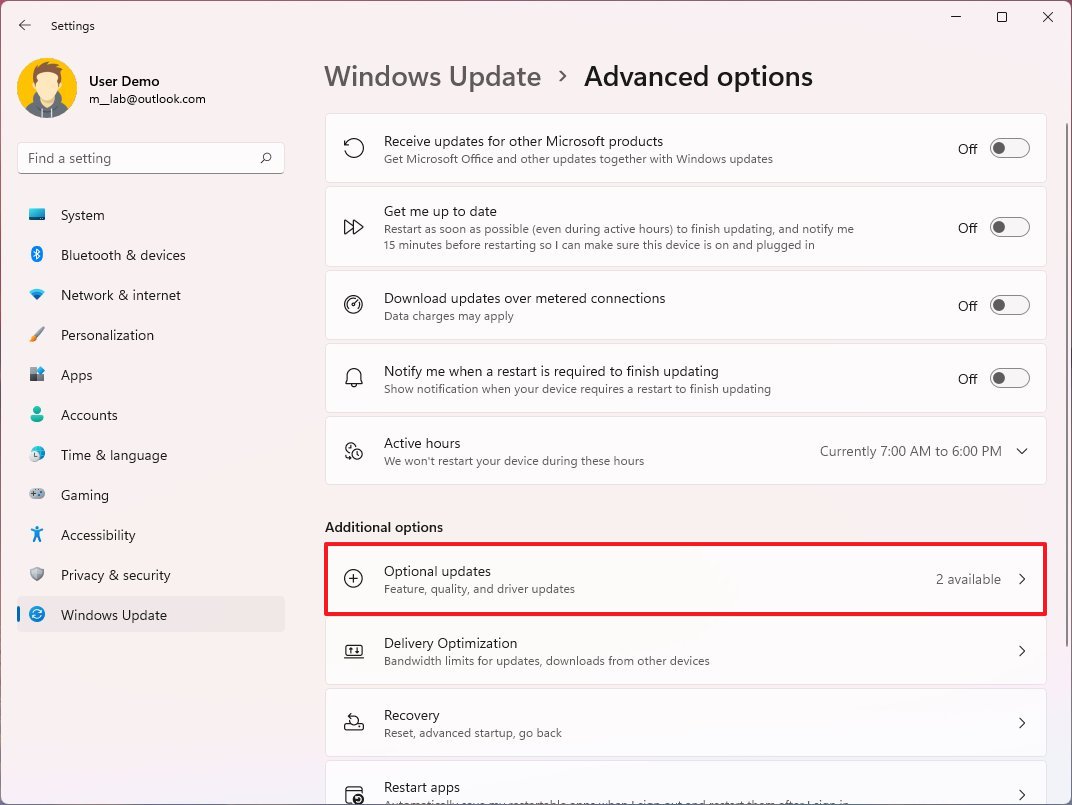
- Click the Driver updates setting.
- Check the device driver update to install.
- Click the Download & install button.
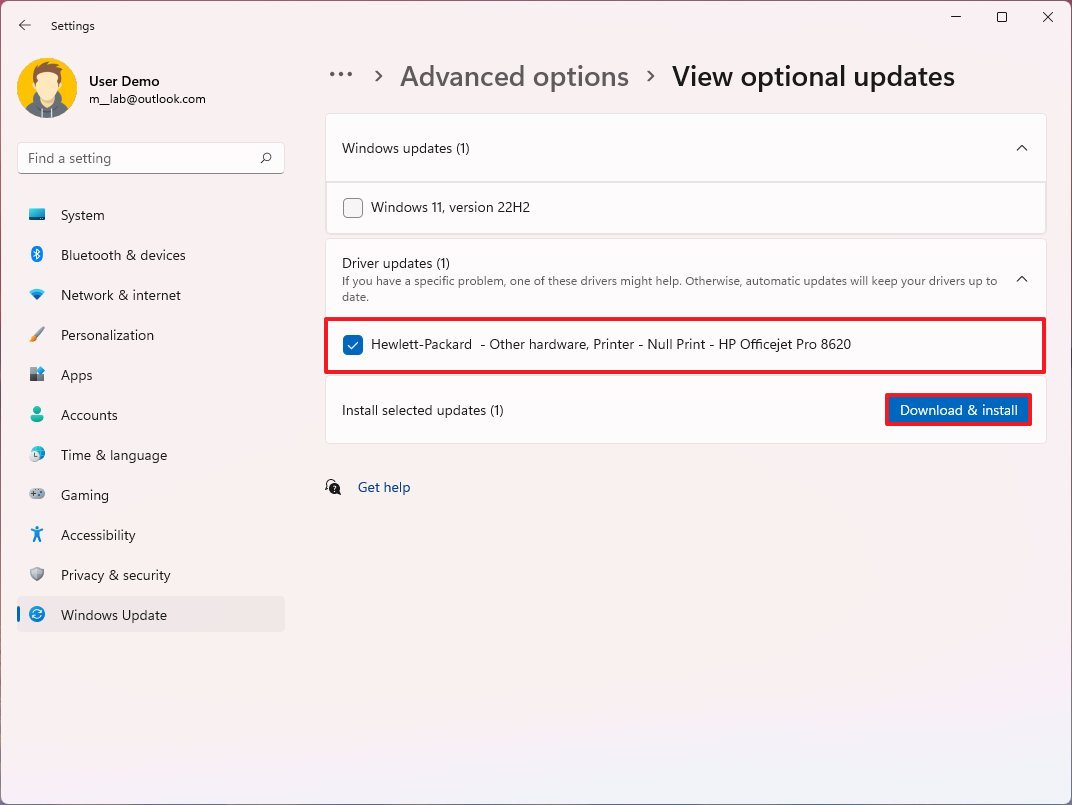
Once you complete the steps, the update will download and install, hopefully fixing the problem in question.
Update adapter driver offline
In the case that the network connection doesn't work, you will have to download the latest network driver available from the manufacturer support website using another computer. If you have a branded device (such as from Dell, Lenovo, or HP), the best option is to download the driver from their websites. If the computer manufacturer driver doesn't work or you cannot find an updated version, you can try downloading the driver from the network adapter manufacturer's website.
To update a wireless or wired adapter manually, use these steps:
- Open Start.
- Search for Device Manager and click the top result to open the app.
- Expand the Network adapters branch.
- Right-click the adapter with the problem and select the Update driver option.
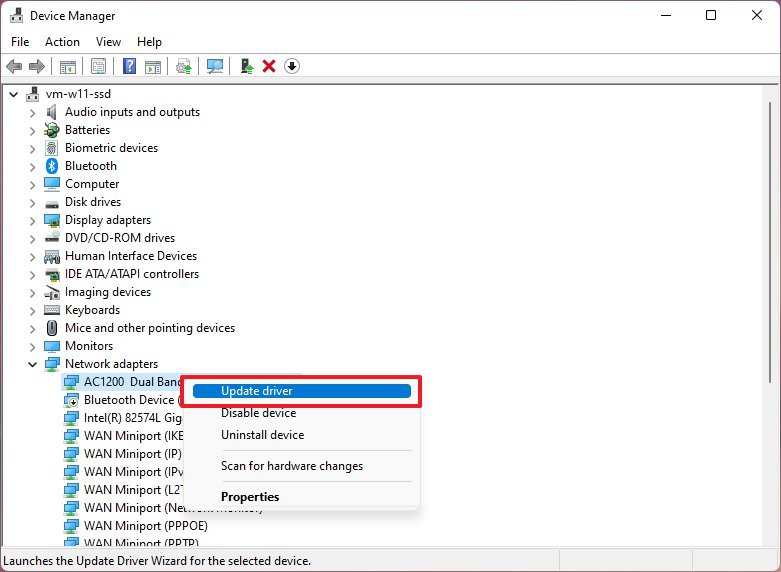
- Click the "Browse my computer for drivers" option.
- Click the Browser button.
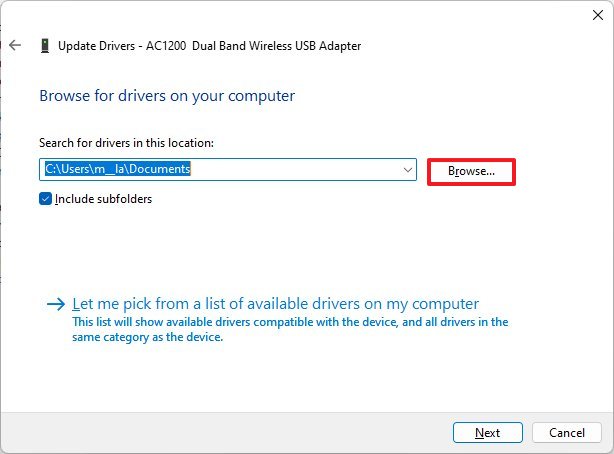
- Select the folder location with the driver package.
- Click the OK button.
- Click the Next button.
- Continue with the on-screen directions (if applicable).
After you complete the steps, the update will install, fixing the compatibility problem on Windows 11.
Rollback previous driver
If the issue appeared after applying a driver update, rolling back to the previous version may fix the problem.
To roll back a driver update to a previous version o Windows 11, use these steps:
- Open Start.
- Search for Device Manager and click the top result to open the app.
- Expand the Network adapters branch.
- Right-click the adapter with the problem and select the Properties option.
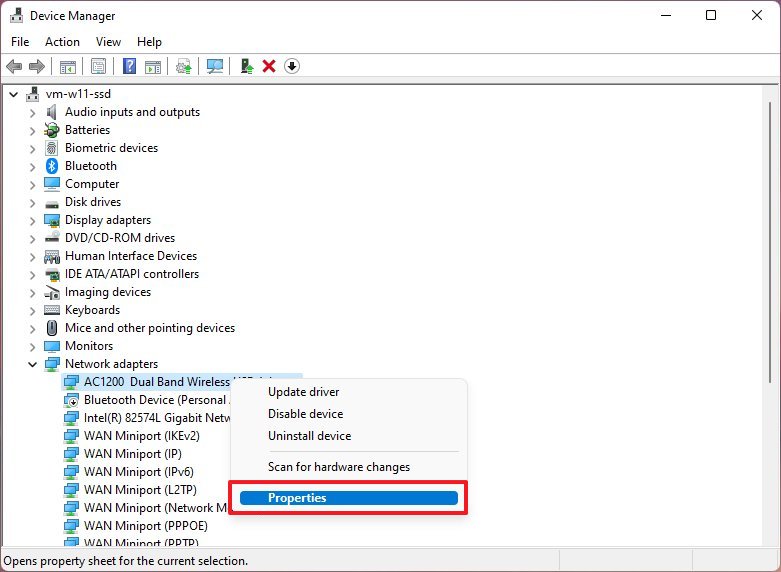
- Click the Driver tab.
- Click the Roll Back Driver button.
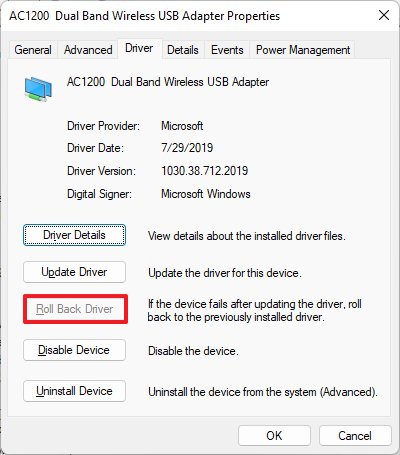
- Quick tip: If the button is grayed out, the system does not have a backup of the driver.
- Click the OK button.
- Select a reason why you are rolling back (select any option).
- Click the Yes button.
- Restart your computer.
Once you complete the steps, confirm whether the internet is working again on Windows 11.
Uninstall network adapter
If you started noticing issues after installing a system update, the update or installation process might have corrupted the driver or made changes to the settings without your consent. This action may fix your problem if you uninstall and reinstall the driver.
To remove the network adapter driver on Windows 11, use these steps:
- Open Start.
- Search for Device Manager and click the top result to open the app.
- Expand the Network adapters branch.
- Right-click the Wi-Fi or Ethernet network adapter and select the Uninstall device option.
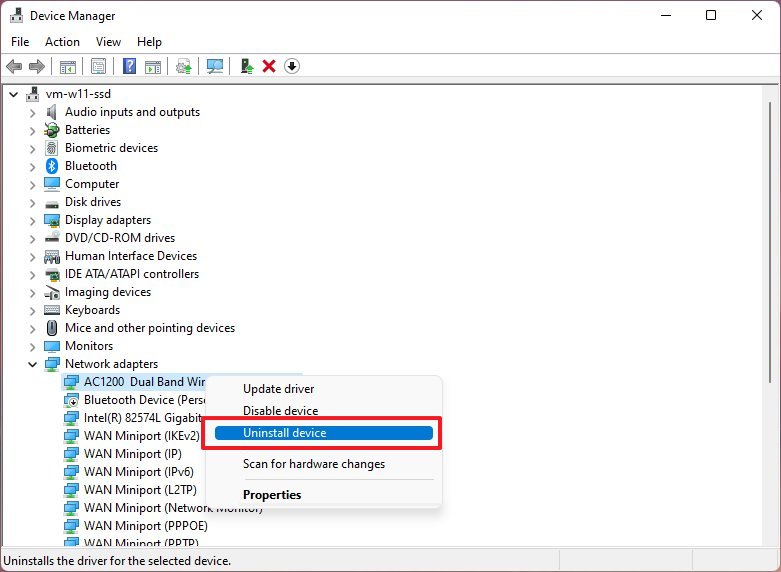
- Click the Uninstall button.
- Restart your computer.
After you complete the steps, the driver will be removed from the computer, and after the restart, the system will detect and reinstall the hardware again.
How to disable security apps to fix internet access
If you use third-party security software for malware and firewall protection, sometimes, these solutions can prevent you from accessing the internet in some way or another. By disabling them and testing connectivity, you can confirm whether the security software is causing problems.
This guide outlines the steps to disable the Microsoft Defender Antivirus and Firewall. If you have another application, check the software support website for more details.
Disable antivirus
To disable the Microsoft Defender Antivirus on Windows 11, use these steps:
- Open Start.
- Search for Windows Security and click the top result to open the app.
- Click on Virus & threat protection.
- Under the "Virus & threat protection settings" section, click the Manage settings option.
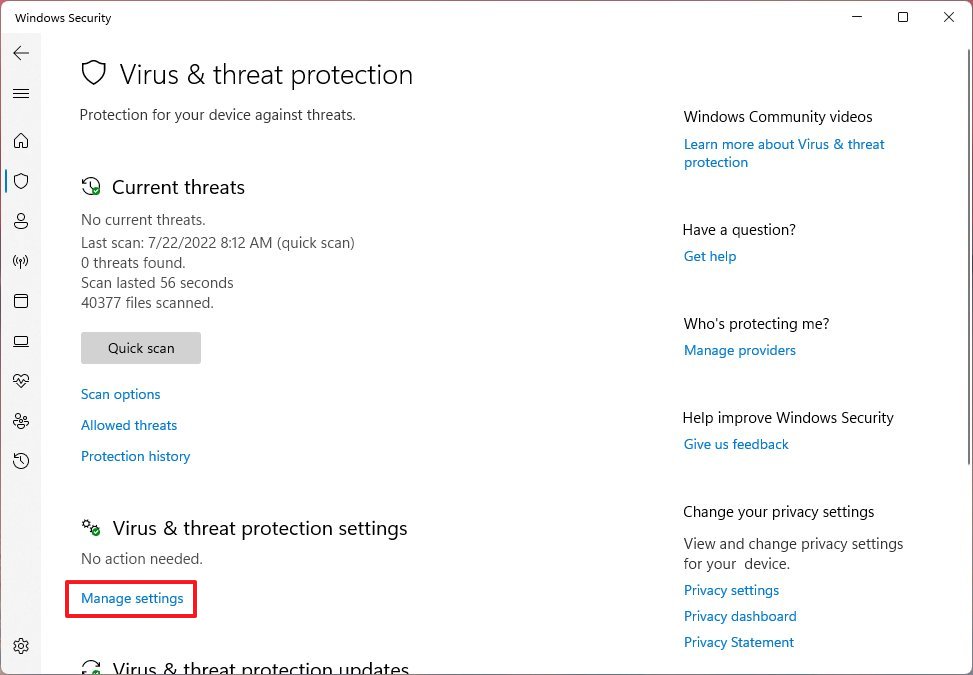
- Turn off the Real-time protection toggle switch.
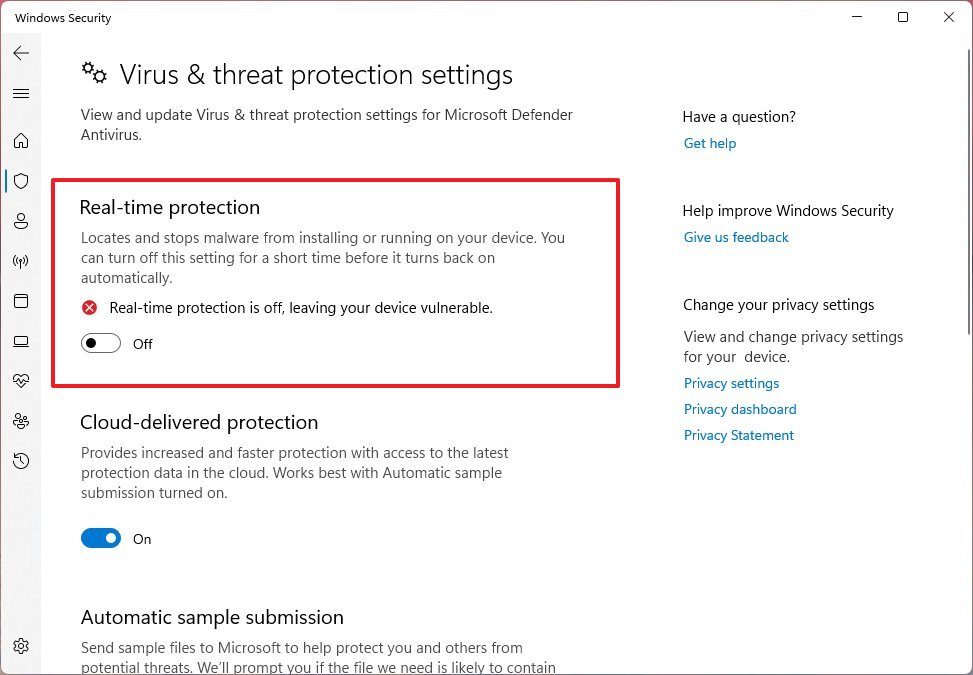
Once you complete the steps, open the web browser and try to load several pages to see whether the internet is working.
It's never recommended to use a computer without an active antivirus. If you want to activate the anti-malware feature, restart the computer or turn on the Real-time protection option again.
Disable firewall
To disable the Microsoft Defender Firewall, use these steps:
- Open Start.
- Search for Windows Security and click the top result to open the app.
- Click on Firewall & network protection.
- Click the (active) network.
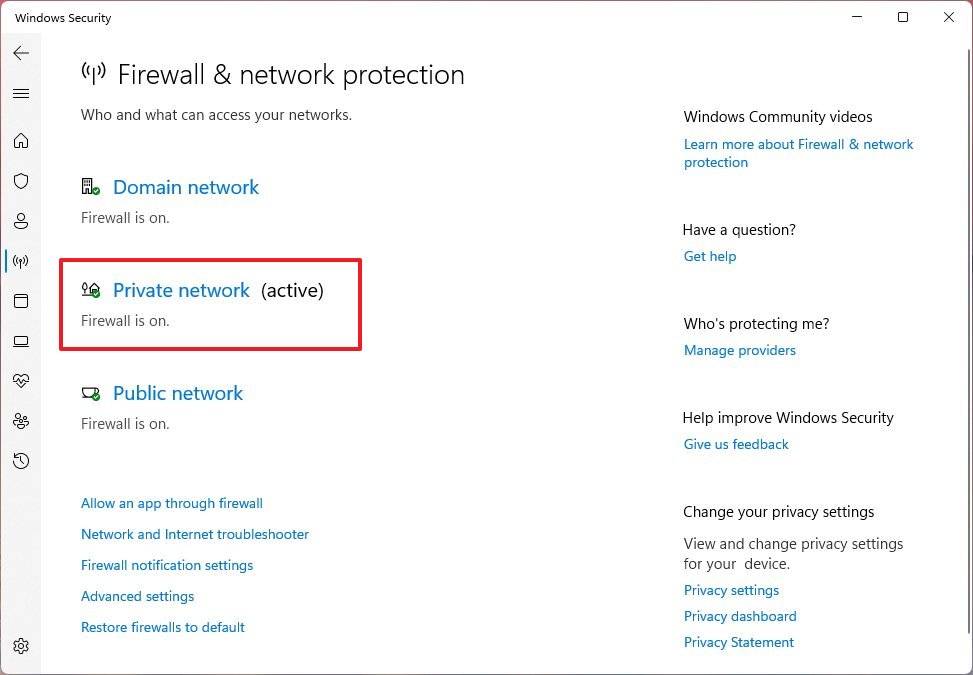
- Turn off the Microsoft Defender Firewall toggle switch.
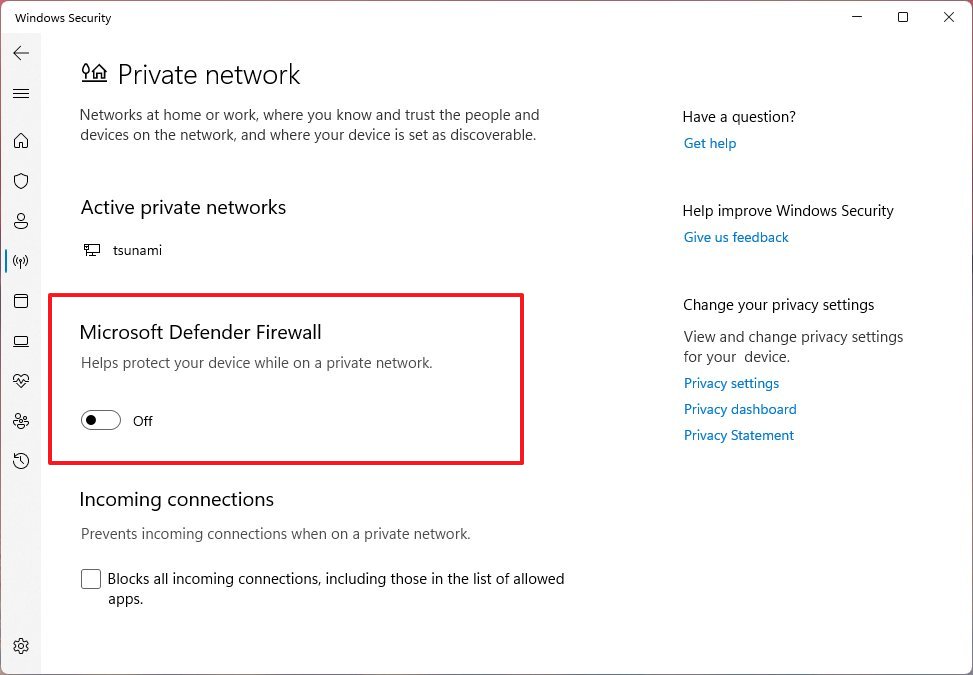
After you complete the steps, try to connect to the internet or the network resource you want to access to confirm the connection is working.
You can enable the firewall again using the same instructions outlined above, but on step 5, make sure to turn on the Microsoft Defender Firewall toggle switch.
How to uninstall update to fix network issues
Microsoft proactively pushes system updates to fix bugs, patch vulnerabilities, and improve the experience with changes and new features. However, nowadays, updates are known to cause a lot of problems. If you know or suspect that a recent update is causing network connection problems, you can uninstall the update to mitigate the issue until there's an update for the system or drive that fixes the problem.
To uninstall a quality update on Windows 10, use these steps:
- Open Settings.
- Click on Windows Update.
- Click the Update history button.
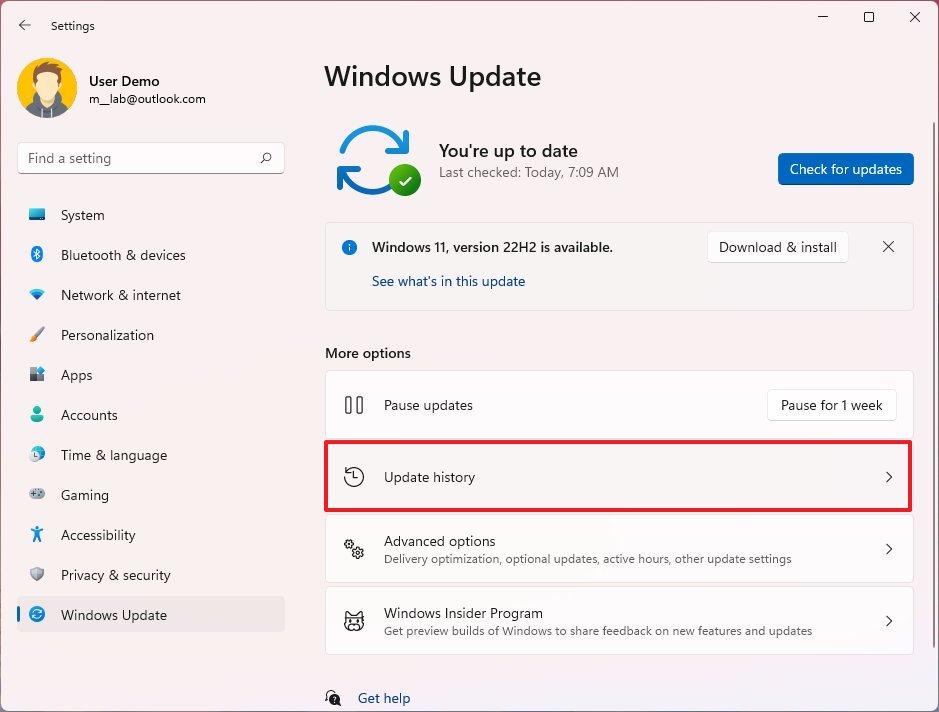
- Click the Uninstall updates option.
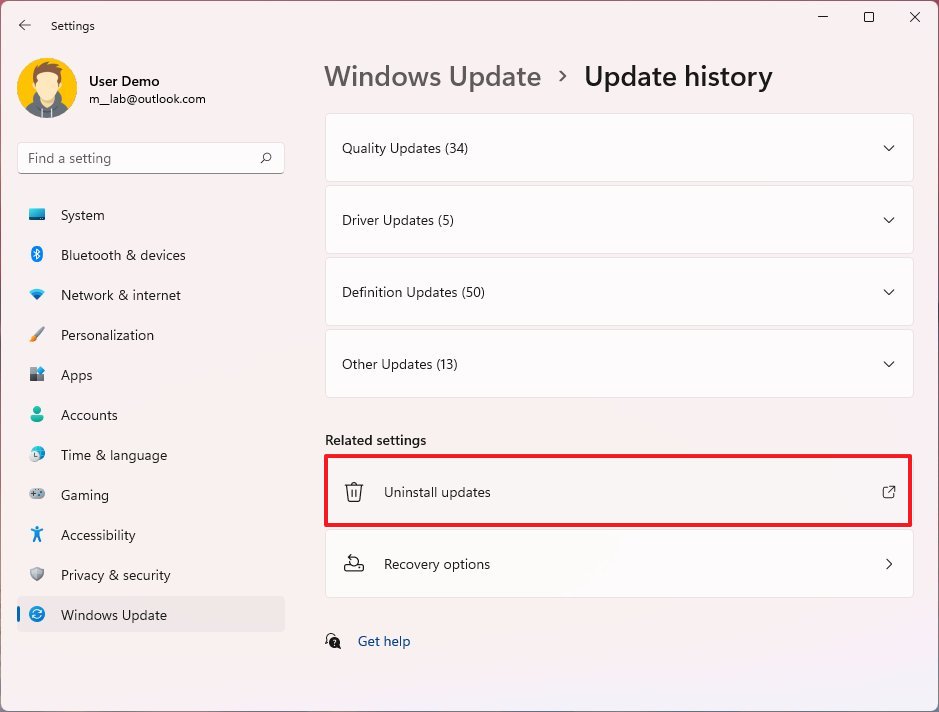
- Select the most recent update causing the network problem on Windows 11.
- Click the Uninstall button.
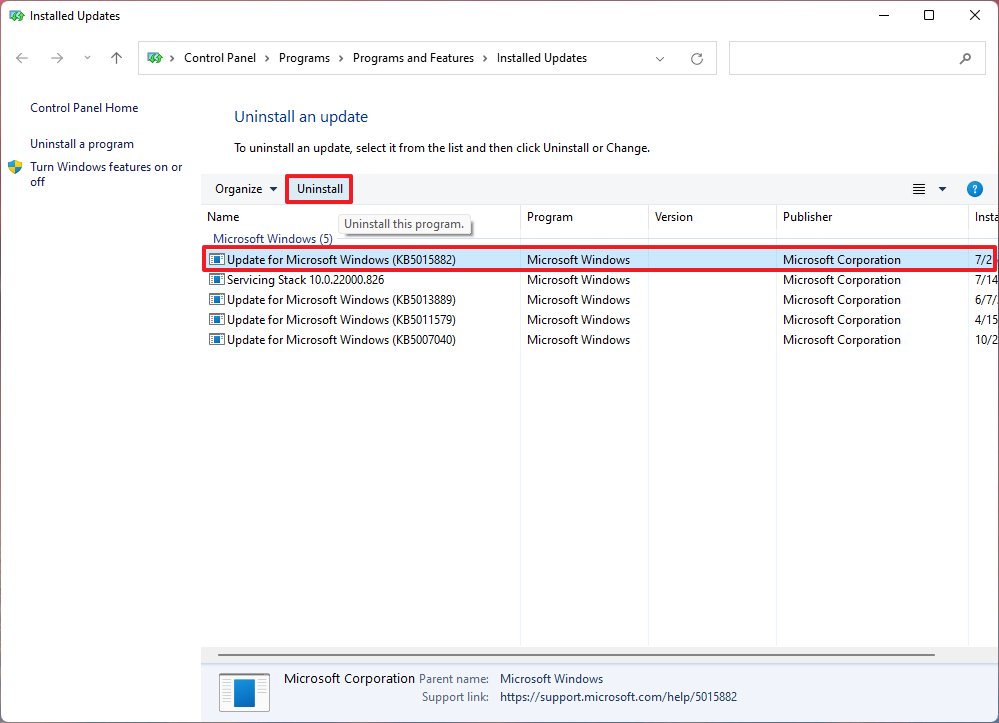
- Click the Yes button.
- Click the Restart now button.
Once you complete the steps, Windows 11 will remove the update, fixing the network adapter.
More resources
For more helpful articles, coverage, and answers to common questions about Windows 10 and Windows 11, visit the following resources:
Mauro Huculak has been a Windows How-To Expert contributor for WindowsCentral.com for nearly a decade and has over 15 years of experience writing comprehensive guides. He also has an IT background and has achieved different professional certifications from Microsoft, Cisco, VMware, and CompTIA. He has been recognized as a Microsoft MVP for many years.

